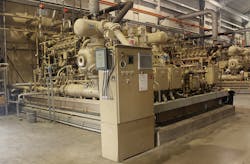Oil prices have dominated news headlines in recent months as OPEC’s decision to keep the global oil supply high has provided much speculation within the U.S. oil and gas industry for 2015. Recently, some drilling companies have cut oil production forecasts, but in the short term, natural gas production numbers should stay steady in 2015.
Meanwhile, mergers and acquisitions in the oil and gas industry have seen companies inherit older control architectures and, with it, some major challenges to provide real-time data.
Electricity and natural gas delivery company CenterPoint Energy-Mississippi River Transmission (CNP-MRT) owns and operates 8,200 miles of transmission pipeline that carried 1.6 trillion cubic feet of gas throughout a nine-state region in one year. Delivering such large volumes of natural gas through pipelines requires adequate pressure, which is accomplished by reciprocating engine compressors typically every 40-100 miles. For CNP-MRT, each compressor station includes an average of four compressor engines, and at least one of the four engines will run at 80 percent 365 days of the year. These school bus-sized engines maintain a pressurized flow—up to 2,500 psi—to reduce gas volume up to 600 times and propel it through a pipeline.
This process entails heavy reliance on data from resistance temperature detectors (RTDs) and thermocouple sensors to control the engine compressors. Unfortunately, CNP-MRT’s legacy automation system provided little visibility for remote management of the equipment, so the company embarked on a pilot project to update its control architecture at one station that moves natural gas across a three-state region—Missouri, Arkansas and Illinois.
Called Horseshoe Lake, CNP-MRT inherited the station’s legacy controls in an acquisition. The seven-year-old station was relatively new, but a system integrator’s build-out of the station included a reliance proprietary control hardware and software.
“Relative to the potential of today’s open architecture, the result was an antiquated control system programmed in a very antiquated way,” says Steve Starkey, the CNP-MRT instrumentation and electronics specialist overseeing the company’s northern pipelines. “Also, CNP-MRT didn’t support the platform that was in use at that facility. So we couldn’t work on the control system ourselves without investing a significant amount of time and money in training.”
For example, simply adding another step in an engine startup sequence required a vendor to reprogram it at an additional cost. Plus, the proprietary architecture’s PLCs were already nearing the end of their life span.
CNP-MRT’s business model revolves around contracts for guaranteed delivery volumes, along with fines for no product, so a data-driven architecture was vital to provide remote monitoring and reduce downtime. The company’s aim was for this station to provide the standard for upgrading the rest of its Midwest region’s compressor fleet.
Operators empowered
For this pilot project at Horseshoe Lake station, CNP-MRT tapped Rockwell Automation’s PlantPAx distributed control system (DCS) and its open-architecture platform to constantly monitor engine operational data, such as speed and load control visibility.
“The trend in compressor operations is collecting, integrating and using higher amounts of data,” Starkey says. “We’re trying to optimize every operational aspect, in real time, that contributes to improved uptime, efficiency and profitability.”
Via FactoryTalk Site Edition (FTSE) and FactoryTalk Machine Edition, CNP-MRT accessed more data on unit performance, emissions and even the safety of engines that pump and run on gas.
The control system also determines which compressor units should start based on engine hours and the number of engines the system controls. “In the past, when you turned on engines individually,” Starkey says, “you started No. 1, then No. 2, and so on. As a result, those units always had more hours. Now, the control system knows to start the engine with the lowest amount of hours, and takes the highest-hour engines offline first.”
Newly added insights into the process include a window on compression by incorporating performance metrics and the situational display of production information at engine, station and pipeline system levels. Other data points are reporting on real-time engine events, along with analysis tools and management dashboards that provide operators localized, role-based information for better decision-making on maintenance shifts.
“Previously, there were many gray areas—too many instances where operators didn’t have control or the necessary insight,” Starkey says. Plus, standardizing on Rockwell Automation’s Library of Process Objects helped decrease system development time and effort.
As a result, CNP-MRT has improved operations capability due to finer control at stations, including alarm management. Previously, there were no alarms other than shutdown; the new DCS now alerts operators via dashboards of engine issues before failure.
“With this pilot, we had to demonstrate that this system was substantially easier for our team to manage than previous systems,” Starkey says. “It had to be more scalable, efficient and reliable than anything purchased previously.”
About the Author
Grant Gerke
Digital Managing Editor

Leaders relevant to this article:
